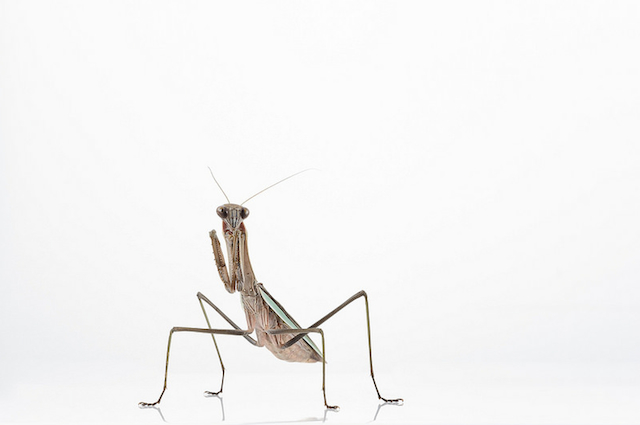Ask A Scientist Insect Edition: Corrie Moreau Answers Your Questions
By Marielle Shaw in Arts & Entertainment on Dec 1, 2014 7:00PM
You may remember Corrie Moreau was last month’s featured scientist in our regular "Ask A Scientist" feature. You had plenty of questions on bugs for her and we were buzzing with anticipation to bring you her answers. Corrie was away from The Field Museum and in the wild doing research in her role as Associate Curator in the Integrative Research Center (Insects), so her answers took a little longer to get to us than usual.
Now that we have them, let's not waste any more time and get you the answers to questions that were…bugging you!
Melissa: What is the most interesting species of ant that lives in Illinois?
CORRIE MOREAU: There are lots of interesting and beautiful ants that live in Illinois. In fact there are more than 130 species in Illinois. You can see images of them on AntWeb.org. One of my favorites are the thatch mound building ants in the genus Formica. If you want to know more about thatch mound building ants and why they build these large nests, be sure to check out this great blog post on AntBlog:
Melissa: Is it possible for spiders to burrow in human skin?
CORRIE MOREAU: No, it is not possible for spiders to burrow into human skin. In fact, spiders very, very, very rarely bite humans. Most wounds that people attribute to spiders are not from spiders at all. Dr. Chris Buddle (McGill University) has two great blog posts about this here and here.
Blue Fairlane: I wage war against ants every spring and summer. I expected last year's hard winter would weaken them and limit their attack, but it had no effect at all. Does winter not affect ants? What do they do with themselves during a Polar Vortex? Do they summer in Florida or something?
CM: Although ants, like most insects, are not very active in the cold and snow many species that live in the soil can buffer themselves from freezing by digging deeper to the warmer parts of the soil. Some ants can dig nests more than 15 feet down into the soil. Even with this buffering strategy, many species also hibernate or become very inactive during the winter months. Also keep in mind that almost all of the ants that live in the Chicago region do very well in the snow, but tropical species that are not native to the area are not likely to be able to survive in our winters.
Carrie Lynn: I'm a sucker for spiders, so whenever I find them around my house, I drop them in my plants to act as security guards. Must have read this somewhere... possibly made it up. Is this a bad idea?
CM: I am glad to hear you are using your resident spiders for biological control (that is what entomologists call using natural enemies to control pest species). Great idea! As I mentioned above, spiders almost never bite people and since they feed on small insects and other invertebrates, they are great to have around to control unwanted visitors to your home.
Carrie Lynn: How DO you get rid of the world's worst insect, the fruit fly? I've tried the whole wine/vinegar left out in a glass thing and still, they live. I know I've helped this whole thing by overwatering my plants, but oh my god, they're never ending.
CM: There are quite a few insects that like to live with humans that we do not always want around. The fruit fly is certainly one of them and your use of wine/vinegar is a great start. But, from the comment about over watering your plants, the fruit flies may not be the only culprit. You may also have fungus gnats living in the soil of your house plants. There are many ways to try to control these including limiting the amount of watering you do, but you can also purchase predatory mites at some garden shops to help control the fungus gnats.
Bill Guerriero: My question—if you grow milkweed to help out butterfly species (like monarchs), should you be concerned about milkweed bugs overrunning or eating the plants?
CM: Glad to hear you are growing milkweed to help promote monarch butterflies. Both the monarch and the milkweed bug feed on milkweed and are native to the areas where they are found. Although in some years milkweed bug numbers can become large, overall their populations do not affect the monarchs. You can find seeds for native milkweeds from the Xerces Society.
Slothlover: As part of your job, do you get the travel to collect ants? If so, where and what do you do with them once you have them back in the lab?
CM: As part of my research I do travel to collect ants. This is important to understand what species are found where and do document biodiversity. These specimens are also used for molecular and genomic work to address questions in evolutionary biology and bio-geography. I have been fortunate in my career to travel to many, many interesting places including Australia, Borneo, Costa Rica, Ecuador, Madagascar, Peru, South Africa, Uganda, Venezula and all over the United States. My favorite places to work in are the rainforests since they have so many species of ants and other organisms. After collecting the ant specimens, I bring them back to The Field Museum to do research with them and add them to the important biological collections that The Field Museum is charged with maintaining as a service to scientists the world over.
As always, take a trip to the Field Museum to see some amazing specimens and perhaps run into a few of their fantastic scientists. Then stay tuned here next week as we introduce our next scientist in the series!
